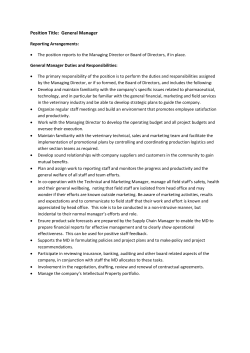
4 Dahl Denmarks National Scheme To Cut Antibiotic Use2
Denmarks National Scheme To Cut Antibiotic Use in Livestock Jan Dahl, DVM Chief Advisor, DVM Danish Agriculture and Food Council Development over time Some reflections on relevance Denmarks National Scheme To Cut Antibiotic Use in Livestock Not a new thing – started 20 years ago Legislation and industry initiatives • Laws • Voluntary bans Focus on animal health many years before that • Pigs — SPF-system for pigs – 1968 Focus on pigs • Low use in cattle • Normally more than 95 % of broilers are not treated Legislation 1994 Separation of sales and veterinary advice Stop for use of generic tetracycline 2000 Vetstat Stop for AGP’s 2000 Ban on fluoroquinolones 2010 Yellow card Voluntary ban on 3. and 4. gen. cephalosporins Industry initiatives AGP’s • Voluntary stop finishers 1998 • Voluntary total stop 2000 Cephalosporins • 2010 voluntary stop for 3. and 4. generation cephalosporins in the pig production • Not used for Danish broilers • Reduced use cattle Separation of advise from sale of antibiotics Stop for use of generic tetracycline Vet not allowed to sell antibiotics (except for 5 days emergency treatment) Health advisory contract between producer and vet • Vet writes prescription to producer • Pharmacy delivers the product • Producer can keep antibiotics for 35 days Tetracycline became more expensive Separation of sales and advice Stop for generics Benefits Removes incentive for overuse Transparent pricing of advise and medicine Farmers organisations and veterinary organisation supported the change Separation of sales and advice Stop for generics Stop for AGP’s Vetstat Vet Pharmacy Producer Data Vetstat Veterinary and Food Adminstration Effect of Vetstat Statistics on antibiotics (and all other medicines) • • • • On country level On type of production-level On farm level On vet-level No direct effect on usage • But necessary for the yellow card initiative 2010 Yellow card initiative Herds with more than double the average consumption ADD – Animal daily doses Placed under extra supervision If not successful in reduction • Second opinion visit • Other restrictions can be inforced – reduction of production level Yellow card limits Boars and sows Weaners Finishers Doses per 100 animals per day until May 2013 5.2 28.0 8.0 Doses per 100 animals per day from June 2013 5.0 25.0 7.0 Doses per 100 animals per day from Dec 2014 4.3 22.9 5.9 Yellow card Yellow card Doses of vaccines (x1,000) Vaccine sales 6000 5000 4000 3000 2000 1000 0 3_2009 4_2009 1_2010 2_2010 3_2010 4_2010 1_2011 Year and quarter of year Respiratory Gastro-intestinal PCV2-related Critically important antibiotics Restrictions on fluoroquinolones • Only for very specific indications Voluntary ban on cephalosporins for pigs • Only for very specific indications Other initiatives Treatment guide made by the Veterinary and Food Administration, universities, veterinary association and industry Increased tax on broad spectrum antibiotics Probably limited effect Animal health initiatives • Pigs — SPF-system for pigs – 1968 SPF-system Managed and owned by the pig production Declaration of all herds in the system Control of all transport trucks Visual control Microbiological control SPF Declaration system Close to 4000 herds declared 73 % the pigs born in the SPF-system • • • • 45 % PRRS positive 16 % AP2 positive 0.5 % swine dysentery positive 2 % Atrophic Rhinitis positive Open declaration of all participating herds www.spf.dk/sus Open to the public Potential buyers Neighbours Information on SPF-status, Salmonella, PRRS Effects on productivity and health Limited to no effect on productivity But we may be at the limit OBSERVATIONS AND REFLECTIONS Are we really focusing on the correct things? Some thoughts based on Scandinavian data European resistance issues Staph. aureus bacteremia Denmark (23 % mortality) 2500 2000 1500 1000 500 0 2007 2008 Staf-bakteriæmi 2009 2010 2011 MRSA-bakteriæmi 2012 2013 MRSA CC398 bakteriæmi 2014 MRSA CC 398 in Europe Based on Dutch, Danish, Italian, Spanish, German papers Approximately 3 % of MRSA across Europe is CC398 Less than 1 % of staph-bacteremias European resistance issues Vancomycin-resistant enterococci No VRE in Danish meat or animals for years European resistance issues ESBL - Scandinavia Danish, Norwegian and Swedish results • Not the same clones in humans and animals • Not the same genes in humans and animals Conclusion Use as much as needed and as little as possible Today I am more worried about treatment effect on animals But focus on what is more important than how much Focus on animal health • Healthy animals do not need antibiotics • Research on solutions and not on
© Copyright 2025










